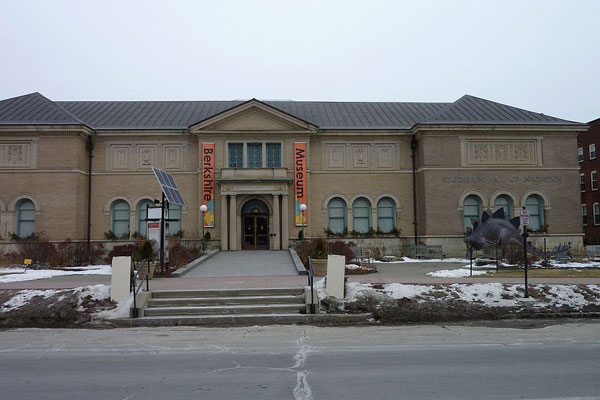
February 9, 2018; Artnet and the New York Times
Last Friday, the Office of the Attorney General of Massachusetts and the Berkshire Museum filed a joint petition with the Supreme Judicial Court of Massachusetts seeking approval of a settlement agreement that would enable the Museum to sell masterworks of art to shore up its financial position, bringing an end to a dispute that has roiled the region since July.
This case, which pitted a struggling museum in Pittsfield, a small formerly industrial town of less than 45,000 people, against many in the nation’s art community, was always a hard one. The museum had been losing money for years, running annual losses of $1 million a year, a high number given the museum’s modest $2.4 million budget. But covering losses wasn’t the entire story. Indeed, the museum board’s vote last July 12th to “deaccession 40 works of art” was done to capitalize a $60 million “reinvention plan” to fund an “exciting new interdisciplinary Museum, with a heightened emphasis on science and history as well as the arts.”
The museum community expressed opposition to the prospect of art being sold at auction to finance a capital plan. Dan L. Monroe and Robert N. Shapiro of the Peabody Essex Museum wrote in an op-ed that the sale would violate the “public trust, donor intentions and a responsibility to serve as prudent stewards of art and other resources given to benefit the public at large.” The Association of Art Museum Directors and the American Alliance of Museums also issued a rare joint letter to oppose the sale. The letter argued that, “One of the most fundamental and longstanding principles of the museum field is that a collection is held in the public trust and must not be treated as a disposable financial asset.”
In November, the state attorney general’s office intervened in favor of those trying to block the sale, on the following grounds:
- Restrictions in state statutes against the sale of 19 of the 40 works of art
- Donor intent regarding ownership of two Norman Rockwell paintings
- Rules requiring that the museum seek permission because the sales “would constitute a fundamental transformation of the Museum, which may only be approved by the court after a showing of impracticability or impossibility.”
The settlement agreement, subject to some limitations—most notably arranging the transfer of a Norman Rockwell masterwork, Shuffleton’s Barbershop, to another nonprofit museum, and a cap on the revenue the museum can earn at auction—concedes the museum’s right to sell the paintings. Among the most relevant Attorney General findings are the following:
Sign up for our free newsletters
Subscribe to NPQ's newsletters to have our top stories delivered directly to your inbox.
By signing up, you agree to our privacy policy and terms of use, and to receive messages from NPQ and our partners.
- The Berkshire Museum faces serious financial challenges, including a dwindling endowment, a weakening fundraising climate, and an annual operating deficit of $1.15 million—that will force it to close within the next several years absent a substantial infusion of capital of approximately $60 million;
- Fundraising alone will not be sufficient to generate the capital necessary to ensure the Museum’s survival;
- The AG’s Office, through its investigation, determined that the Berkshire Museum met its demonstrated financial need to deaccession assets; [and]
- A two-year Master Planning Process, including extensive input from hundreds of members of the community, financial guidance from a respected non-profit consultant, and consideration of alternatives to deaccession, led to development of a plan that will allow the Museum to continue fulfilling its mission.
In short, the Attorney General’s office concluded that the museum’s board had exercised appropriate duty of care in coming to its decision to sell the art.
The American Alliance of Museums and the Association of Art Museum Directors conceded this point, but were not pleased: “While the negotiated agreement with the Berkshire Museum may satisfy legal standards, it falls far short of ethical standards and best practices for museums. This is indeed a sad day for the arts community in the Berkshires and the museum community across the country.”
The agreement, which requires court approval, “could end a contentious chapter in the history of the museum,” writes Colin Moynihan of the New York Times. Moynihan adds that, “The sales, set to be handled by Sotheby’s, are now likely to go forward, though under the agreement they will stop when proceeds to the museum reach $55 million.”
“This agreement helps secure the future of the Berkshire Museum for years to come, while preserving Shuffleton’s Barbershop for public view, in keeping with the wishes of Norman Rockwell,” Maura Healey, Attorney General for Massachusetts, said in a statement.
Eileen Kinsella in Artnet notes that the not-yet-identified nonprofit museum that bought Shuffleton’s Barbershop would lend the work to the local Norman Rockwell Museum “for up to two years. The new owner will also explore subsequently loaning the work to other Massachusetts museums before it leaves the state for its new home.”
With the settlement, the Berkshire arts dispute is coming to a close, but we can surely expect others in its wake. The arts world would do well to work proactively with smaller museums to devise creative solutions (such as art loan programs) that shore up finances and preserve art for public consumption.—Steve Dubb












